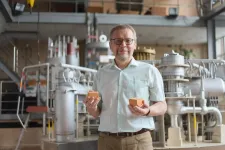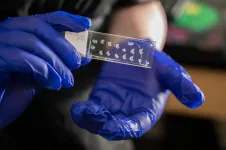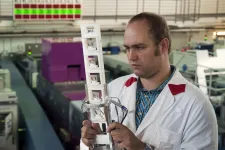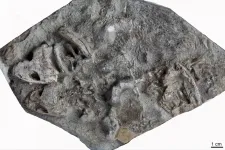Water treatment: Removing hormones with sunlight
KIT researchers developed a new method to remove micropollutants using a photocatalytic membrane and visible light
2021-05-21
(Press-News.org) Micropollutants such as steroid hormones contaminate drinking water worldwide and pose a significant threat to human health and the environment even in smallest quantities. Until now, easily scalable water treatment technologies that remove them efficiently and sustainably have been lacking. Scientists at the Karlsruhe Institute of Technology (KIT) developed a new chemical process for removing hormones. It takes advantage of the mechanisms of photocatalysis and transforms the pollutants into potentially safe oxidation products. The team reports on this in the scientific journal Applied Catalysis B: Environmental.
Organic pollutants such as pharmaceuticals, pesticides, and hormones - even at nanoscale concentrations - contaminate drinking water in a way that poses significant risks to humans, animals, and the environment. In particular, the steroid hormones estrone, estradiol, progesterone, and testosterone can cause biological damage in humans and wildlife. The European Union has therefore set strict minimum quality standards for safe and clean drinking water, which must also be taken into account in the development of new technologies for water treatment. "The challenge for science is to develop more sensitive methods to target the hormone molecules," says Professor Andrea Iris Schäfer, Head of the Institute for Advanced Membrane Technology (IAMT) at KIT. The main problem is that steroid hormones are very hard to detect in water. "There is one hormone molecule for every quintillion water molecules. This is an extremely low concentration," explains the expert.
Detecting - and Removing - Micropollutants
With conventional water treatment technologies, wastewater treatment plants can neither find nor remove micropollutants. Researchers at the IAMT and the KIT Institute of Microstructure Technology (IMT) are therefore working on new methods to not only detect and measure micropollutants, but also remove them. A new, photocatalytic process proves to be promising. The scientists coated a commercially available large-pore polymer membrane with Pd(II)-porphyrin, a palladium-containing, light-sensitive molecule that can absorb visible radiation. Exposure to radiation with simulated sunlight initiates a chemical process that produces so-called singlet oxygen, a highly reactive oxygen species. The singlet oxygen specifically "attacks" the hormone molecules and converts them into potentially safe oxidation products. "It is crucial that we coat the surface of each pore with the photosensitizer molecule, increasing the surface area of attack," explains Roman Lyubimenko, a scientist at IAMT and IMT.
Significant Reduction of the Estradiol Concentration
The chemical decomposition of steroid hormones and the filtration of other micropollutants can be realized in a single module. With this process, filtering of 60 to 600 liters of water per square meter of membrane is possible in one hour. The scientists were able to reduce the concentration of estradiol, the most biologically active steroid hormone, by 98 percent from 100 to 2 nanograms per liter. "This means that we are already very close to the EU target value of one nanogram per liter," emphasizes Schäfer. The next goal of the research team is to further optimize the photocatalytic process and transfer it to a larger scale. Open issues are to find out how much light intensity and how much porphyrin will be needed and whether the costly palladium from the platinum group of metals can be replaced by other metals. (sur)
INFORMATION:
Original publication:
Roman Lyubimenko, Oscar Ivan Gutierrez Cardenas, Andrey Turshatov, Bryce Sydney Richards, & Andrea Iris Schäfer. Photodegradation of steroid-hormone micropollutants in a flow-through membrane reactor coated with Pd(II)-porphyrin. Applied Catalysis B: Environmental, 2021. DOI: 10.1016/j.apcatb.2021.120097
https://doi.org/10.1016/j.apcatb.2021.120097 (abstract)
More information: https://www.iamt.kit.edu/
Contact for this press release:
Sandra Wiebe, Press Officer, phone: +49 721 608-41172, e-mail: sandra.wiebe@kit.edu
Being "The Research University in the Helmholtz Association", KIT creates and imparts knowledge for the society and the environment. It is the objective to make significant contributions to the global challenges in the fields of energy, mobility, and information. For this, about 9,600 employees cooperate in a broad range of disciplines in natural sciences, engineering sciences, economics, and the humanities and social sciences. KIT prepares its 23,300 students for responsible tasks in society, industry, and science by offering research-based study programs. Innovation efforts at KIT build a bridge between important scientific findings and their application for the benefit of society, economic prosperity, and the preservation of our natural basis of life. KIT is one of the German universities of excellence.
[Attachments] See images for this press release:
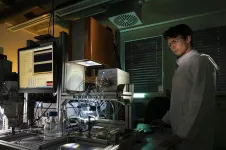
ELSE PRESS RELEASES FROM THIS DATE:
2021-05-21
The findings of a clinical trial by Trinity College Dublin researchers of treatment for atopic dermatitis have been published today in The Lancet journal (Friday, 21st May, 2021). Results of the clinical trial at the School of Medicine, Trinity College and St James's Hospital, Dublin have shown the drug upadacitinib to be the most effective treatment to date for this chronic, relapsing inflammatory condition. The research is vital as there is an unmet need which exists for therapies that provide remission of symptoms in moderate-to-severe atopic dermatitis.
The publication reports efficacy and safety results of upadacitinib compared with placebo for the treatment of moderate-to-severe atopic dermatitis in adults and adolescents. This pivotal Global Phase ...
2021-05-21
An international study led by the ICTA-UAB states that recognizing indigenous peoples' and local communities' rights and agency is critical to addressing the current biodiversity crisis
Policies established by the post-2020 Global Biodiversity Framework of the Convention on Biological Diversity (CBD) could be ineffective if the rights and agency of indigenous peoples and local communities are not recognized and fully incorporated into biodiversity management. This is supported by an international study led by the Institute of Environmental Science and Technology of the Universitat Autònoma de Barcelona (ICTA-UAB) and recently published in the journal Ambio.
The ...
2021-05-21
Scientists at the Ural Federal University (UrFU, Russia) have created clay bricks that are able to attenuate ionizing radiation to a level that is safe for the human body. To the composition of bricks scientists add waste from the industry, which protects against radiation. The article describing the technology was published in the journal Applied Radiation and Isotopes.
"Bricks are a relatively cheap and convenient material with which we can quickly erect protective rooms, structures, walls around objects with radiation," says scientific head of the project, associate professor of the Department of Nuclear Power Plants and Renewable Energy Sources at UrFU Oleg Tashlykov. "The bricks ...
2021-05-21
Chronic skin itching drives more people to the dermatologist than any other condition. In fact, the latest science literature finds that 7% of U.S. adults, and between 10 and 20% of people in developed countries, suffer from dermatitis, a common skin inflammatory condition that causes itching.
"Itch is a significant clinical problem, often caused by underlying medical conditions in the skin, liver, or kidney. Due to our limited understanding of itch mechanisms, we don't have effective treatment for the majority of patients," said Liang Han, an assistant professor in the Georgia Institute of Technology's School of Biological Sciences who is also a researcher in the Parker H. Petit Institute for Bioengineering and Bioscience.
Until ...
2021-05-21
When Charles Darwin published Descent of Man 150 years ago, he launched scientific investigations on human origins and evolution. This week, three leading scientists in different, but related disciplines published "Modern theories of human evolution foreshadowed by Darwin's Descent of Man," in Science, in which they identify three insights from Darwin's opus on human evolution that modern science has reinforced.
"Working together was a challenge because of disciplinary boundaries and different perspectives, but we succeeded," said Sergey Gavrilets, lead author and professor in the Departments of Ecology and Evolutionary Biology and Mathematics at the University of Tennessee, Knoxville.
Their goal with this review summary was to apply the framework ...
2021-05-21
CLEVELAND - Follow-up data from the landmark SPRINT study of the effect of high blood pressure on cardiovascular disease have confirmed that aggressive blood pressure management -- lowering systolic blood pressure to less than 120 mm Hg -- dramatically reduces the risk of heart disease, stroke, and death from these diseases, as well as death from all causes, compared to lowering systolic blood pressure to less than 140 mm Hg. Systolic blood pressure (SBP) is the upper number in the blood pressure measurement, 140/90, for example.
In findings published in the May 20, 2021 issue of the New England Journal of Medicine, investigators presented new evidence of the effectiveness of reducing SBP to a target range of less than 120 ...
2021-05-21
Depressive disorders are among the most frequent illnesses worldwide. The causes are complex and to date only partially understood. The trace element lithium appears to play a role. Using neutrons of the research neutron source at the Technical University of Munich (TUM), a research team has now proved that the distribution of lithium in the brains of depressive people is different from the distribution found in healthy humans.
Lithium is familiar to many of us from rechargeable batteries. Most people ingest lithium on a daily basis in drinking water. International studies have shown that ...
2021-05-21
Beijing, 19 May 2021: the journal Cardiovascular Innovations and Applications (CVIA) has just published a new issue, Volume 5 Issue 4.
This issue brings together important research from leading cardiologists in US and China in a combination of reviews, original research and case reports.
REVIEWS
Pei Huang, Yi Zhang, Yi Tang, Qinghua Fu, Zhaofen Zheng, Xiaoyan Yang and Yingli Yu
Progress in the Study of the Left Atrial Function Index in Cardiovascular Disease:
A Literature Review (https://tinyurl.com/3vruva37)
Nikhil H. Shah, Steven J. Ross, Steve A. Noutong Njapo, Justin Merritt, Andrew Kolarich, Michael Kaufmann, ...
2021-05-21
Social scientists have had a longstanding fixation on moral character, demographic information, and socioeconomic status when it comes to analyzing crime and arrest rates. The measures have become traditional markers used to quantify and predict criminalization, but they leave out a crucial indicator: what's going on in the changing world around their subjects.
An unprecedented longitudinal study, published today in the American Journal of Sociology, looks to make that story more complete and show that when it comes to arrests it can come down to when someone is rather than who someone is, a theory the researchers refer to as the birth lottery of history.
Harvard sociologist Robert J. Sampson and Ph.D. candidate Roland Neil followed arrests in the lives of more than ...
2021-05-21
Paleontologists had to adjust to stay safe during the COVID-19 pandemic. Many had to postpone fossil excavations, temporarily close museums and teach the next generation of fossil hunters virtually instead of in person.
But at least parts of the show could go on during the pandemic -- with some significant changes.
"For paleontologists, going into the field to look for fossils is where data collection begins, but it does not end there," said Christian Sidor, a University of Washington professor of biology and curator of vertebrate paleontology ...
LAST 30 PRESS RELEASES:
[Press-News.org] Water treatment: Removing hormones with sunlight
KIT researchers developed a new method to remove micropollutants using a photocatalytic membrane and visible light


